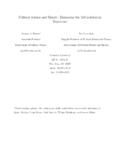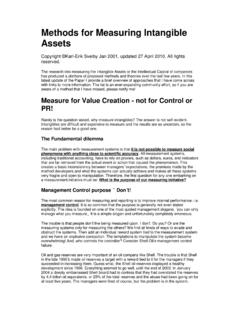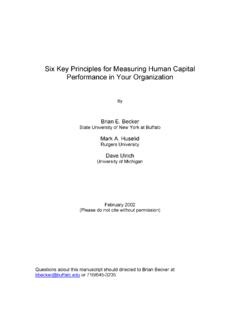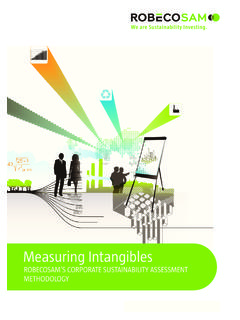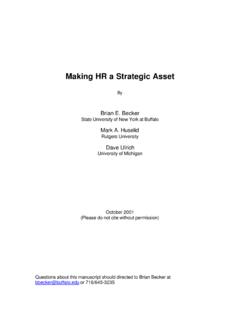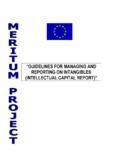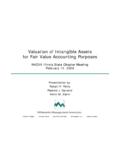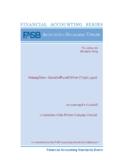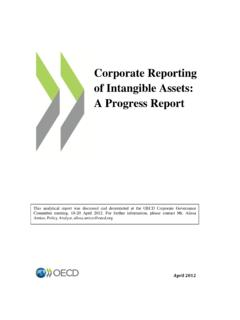Transcription of Fair Value Accounting in the Banking Industry
1 Fair Value Accounting in the Banking Industry Occasional Paper Series Center for Excellence in Accounting & Security Analysis Columbia Business School established the Center for Excellence in Accounting and Security Analysis in 2003 under the direction of Trevor Harris and Professor Stephen Penman. The Center ( CEASA ) aims to be a leading voice for independent, practical solutions for financial reporting and security analysis, promoting financial reporting that reflects economic reality and encourages investment practices that communicate sound valuations. CEASA's mission is to develop workable solutions to issues in financial reporting and Accounting policy; produce a core set of principles for equity analysis; collect and synthesize best thinking and best practices; disseminate ideas to regulators, analysts, investors, accountants and management; and promote sound research on relevant issues.
2 Drawing on the wisdom of leading experts in academia, Industry and government, the Center produces sound research and identifies best practices on relevant issues. CEASA's guiding criterion is to serve the public interest by supporting the integrity of financial reporting and the efficiency of capital markets. Located in a leading university with a mandate for independent research, CEASA is positioned to lead a discussion of issues, with an emphasis on sound conceptual thinking and without obstacles of constituency positions. More information and access to current research is available on our website at The Center is supported by our generous sponsors: General Electric, IBM and Morgan Stanley.
3 We gratefully acknowledge the support of these organizations that recognize the need for this center. FAIR Value Accounting IN THE Banking Industry . Principal Consultant Doron Nissim; Professor, Columbia Business School; Chair of the Accounting Department, Columbia Business School Project Coordinator Stephen Penman; George O. May Professor of Accounting , Columbia Business School; Co-Director, CEASA. May 2007. Table of Contents I. INTRODUCTION ..4. II. BANKS' FINANCIAL STATEMENTS AND A. Sample .. 10. B. Common-Size Balance 11. C. Common-Size Income 13. D. Profitability .. 15. III. ANALYSIS OF A. Cash and Balances Due from Depository 18.
4 B. Federal Funds Sold and Securities Purchased under Agreements to 20. C. 22. Accounting Treatment and Classification .. 22. Unrealized Gains and Losses .. 24. Composition and Risk .. 25. Estimation and Limitations of Fair Value .. 30. Academic 31. D. Trading Assets .. 32. E. Loans and 33. Accounting Treatment and Classification .. 33. 35. Risk 36. Estimation, Accuracy and Limitations of Fair Value .. 39. Academic 42. F. Other Financial 44. G. Premises and 45. H. Intangible 46. I. Other 49. IV. ANALYSIS OF A. Federal Funds Purchased and Securities Sold under Agreements to Repurchase .. 51. B. Trading Liabilities .. 52. C. Deposits.
5 53. Accounting Treatment, Composition and Risk .. 53. Estimation of Fair Value .. 55. Academic 56. D. 56. Accounting Treatment and Composition .. 56. Risks and Estimation of Fair Value .. 57. Center for Excellence in Accounting & Security Analysis 1. Academic 57. E. Other Liabilities .. 58. V. DERIVATIVES AND OFF-BALANCE-SHEET ITEMS ..59. A. 59. B. 60. C. Letters of 61. D. Credit 62. E. Derivatives (Other than Credit) .. 64. Accounting 64. Classification .. 66. Composition and Risk .. 68. Estimation of Fair Value .. 69. Academic 70. VI. CONCLUSION ..71. REFERENCES ..72. Center for Excellence in Accounting & Security Analysis 2.
6 Overview This paper studies the application of fair Value Accounting in bank holding companies in the United States with the purpose of evaluating the effects of expanding fair Value Accounting in the Banking Industry . The paper documents the current application of fair Value Accounting in the Industry , showing what proportions of recognized assets and liabilities of bank holding companies are at or close to fair Value on the balance sheet, have related unrealized gains and losses in income, or have fair values disclosed in the footnotes. In each case, it evaluates the advantages and disadvantages of the current treatment and makes an assessment of the magnitudes of economic assets and liabilities that currently are omitted from the balance sheet.
7 Turning to the issue of the likely impact of expanded application of fair values, the paper asks how large are the actual and potential differences between fair values and book values of various assets and liabilities and how credit, interest rate and prepayment risks are likely to determine those differences. It considers the availability of market-based information for measuring fair Value and evaluates the correlations between fair values of economic assets and liabilities due to natural hedges, asset-liability management, and changes in asset values affecting the risk and Value of liabilities. It also addresses the issue of how a switch to fair Value Accounting would mitigate or, alternatively, facilitate earnings management activities.
8 The primary conclusion of the analysis is that expanding fair Value Accounting is not likely to significantly improve the information in bank financial statements and, in some cases, may introduce distortions that reduce Accounting quality. The analysis is pertinent to bank analysts and investors for it not only documents the impact of fair Value Accounting on banks but also informs about the drivers of Value and risk on which Accounting should report. Center for Excellence in Accounting & Security Analysis 3. I. Introduction This paper studies the application of fair Value Accounting in the Banking Industry . Its primary objective is to inform on the applicability of fair Value Accounting in the Banking Industry and the desirability of adopting standards which will expand fair Value reporting.
9 To achieve this goal, this research presents relevant evidence that addresses the following issues and questions: (a) The current application of fair Value Accounting 1) What proportions of recognized assets and liabilities of bank holding companies (BHCs) are reported at or close to fair Value on the balance sheet, have related unrealized gains and losses recognized in income, or have fair values disclosed in footnotes? 2) What are the magnitudes of economic assets and liabilities which are omitted from the balance sheet? (b) The likely impact of implementing fair Value Accounting on various assets, liabilities, and off-balance sheet items 3) For each item, how large are the actual and potential differences between fair and book values?
10 4) How important are credit, interest rate, and prepayment risks? (This analysis is important because high risk implies high likelihood of significant differences between fair and book values; in addition, the precision of pricing varies across exposures.). 5) What is the availability and quality of market-based information for measuring fair Value ? 6) What are the fair Value correlations with other economic assets and liabilities, and what are the sources of these correlations ( , natural hedge, asset-liability management, impact of changes in assets Value on the risk and Value of liabilities)? (c) The Accounting treatment of various assets, liabilities, and off-balance sheet items 7) What is the current Accounting treatment and what are its advantages and disadvantages?









